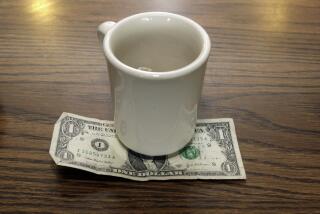Taking a Valuable Tip : Gratuity Jars Offer Fast-Food Workers a Welcome Change of Pace
- Share via
It is late afternoon at Jody Maroni’s Sausage Kingdom in Santa Monica, and workers are busy filling orders for Louisiana Boudin Hot Links and other sandwich specialties.
Many customers seem so hungry or otherwise preoccupied that they hardly notice a plastic container beside the cash register. Marked “tips,” the container held a couple of dollar bills and some change.
“We’re very democratic here,” Jack, a manager who declined to give his last name, said of the tip jar. “We evenly distribute the money among the workers, from dishwasher to cook.”
Three or four workers sometimes divvy up as much as $30 by the end of an eight-hour shift, he said.
Welcome to today’s hardscrabble fast-food workplace, where the workers at some establishments are increasingly depending on tips to supplement paychecks. Many workers in these restaurants earn the minimum wage, $4.50 per hour.
Waiters and waitresses have long been tipped 15% or more of a restaurant check for serving food at tables. But the trend in fast-food tipping usually benefits cashiers, cooks, dishwashers and other behind-the-counter staff, according to interviews with restaurant owners and managers.
*
On the Westside, tip jars are commonly found in the food courts of tony shopping malls such as Santa Monica Place. Usually, small independent restaurants accept the practice more readily than large fast-food chains. Miami-based Burger King, for example, has a policy against tips at company-owned outlets, spokeswoman Kim Miller said.
Workers say the phenomenon may have started years ago at coffeehouses, where counter help often received tips for preparing a cup of cappuccino.
“Coffee can be perfect or lousy; you have to add the right amount of water,” said Robb Howard, manager of the Rose Cafe in Venice, a coffee shop and restaurant that has its own tip jar. If the coffee was good, “sometimes you’d give the person who made it an extra 50 cents.”
Howard can remember making as much as $25 in tips during an eight-hour shift.
Beatrice Haro, an 18-year-old high school student who helps run the counter at Rose, said she can earn $15 or more per shift in tips. Her wage is $5.50 per hour.
“It’s extra money I’m not counting on,” Haro said. “I can go out to lunch on it, so it’s really helpful.”
Fast-food workers do not always see big returns, however.
John Mahdavi, owner of the Charlie Kabob restaurant in Santa Monica Place, said he allowed three counter workers to start a tip cup several months ago. But he estimated that the idea has so far netted only $15 or so per week.
“It’s not that much money,” Mahdavi said with a shrug and a smile, “but if it makes them happy, so what?”
The fact that such unofficial income is typically tax-free may make many workers happy. While waiters and waitresses must report tips to the Internal Revenue Service, some managers privately admit that there is no formal procedure for reporting tips at the cash register. An IRS spokesman could not be reached for comment.
“There are lots of people in lots of jobs who would like to find ways to get money and not get taxed,” said David Lewin, professor of human resources at UCLA. “This is the counter man’s tax shelter.” He added that the minimum wage has not risen as fast as the average factory wages in the past 15 years--a trend that could put pressure on workers to seek extra sources of income.
*
But customers rarely trouble themselves with such arcane economic issues. Some seem never to notice tip jars, while others toss in spare change as if by reflex.
Mike Maross, a West Los Angeles office worker, swung by Jody Maroni’s to pick up some sandwiches for himself and other employees.
“I usually don’t notice [tip jars], but it’s probably because I don’t want to know,” Maross admitted. But before leaving he opened his wallet and stuck a dollar in the jar.
More to Read
Eat your way across L.A.
Get our weekly Tasting Notes newsletter for reviews, news and more.
You may occasionally receive promotional content from the Los Angeles Times.











